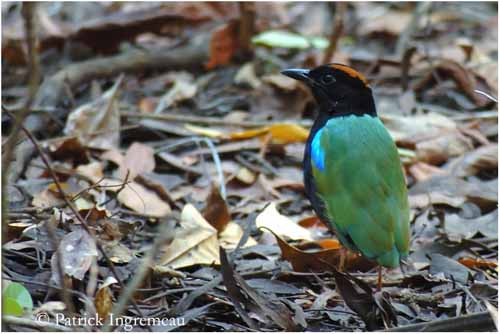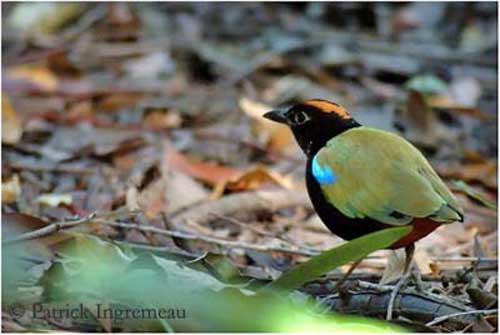
Rainbow Pitta
Pitta iris
Passeriforme Order – Pittidae Family
BIOMETRICS:
L: 16-18 cm
Poids: 60-65 gr
DESCRIPTION:
Rainbow Pitta is endemic to Australia.
Adult male has bright green upperparts and rump. Sides of mantle can often show iridescent golden gloss, and we can see sometimes a slight blue tinge, giving paler aspect than usual. Tail is olive-green. Upper wings show bright glossy blue shoulder patch.
Underparts are mainly black, except on lower flanks and vent which are chestnut. Under wings are black. Undertail coverts are reddish-pink.
Head, chin and throat are black, forming a kind of hood. Crown is marked with broad chestnut-brown band. This band can vary from short streak to patch on nape.
Strong, conical bill is black. Eyes are dark brown. Legs are flesh-coloured to reddish-grey, whereas feet are darker, brown or blackish.
This species performs several displays, such as “bowing”, used to maintain territorial boundaries. Two birds stand upright in stiff posture, and alternate bowing and upright posture, in slow motion. This display occurs along boundaries, and birds utter purring-like calls. This display probably maximise the shoulder patch shining of males.
Other behaviour is used as an alarm, or as lure in front of predators. During this display, adult flicks its wings regularly, while it gives a loud “keow”.
If intruder approaches the nest, adults perform wing spreading display, always giving alarm calls. Wings are partially opened and raised.
The last behaviour shows the Rainbow Pitta bending forwards with tail in the air and breast almost touching the ground, and head stretched backwards with bill pointing upwards.
Rainbow Pitta is probably sedentary, but young birds can disperse. Adults remain in the same territory all year round. Rainbow Pitta is very shy.
FLIGHT: no information.
REPRODUCTION:
Breeding season occurs from mid-October to February-March, varying with rainy season. Nesting occurs during wet season.
Rainbow Pitta nests in trees, at about 20 metres above the ground, but nest can be built in clumps of bamboo, thickets, on tree stumps or logs among fallen debris, and even on the ground between tree roots.
Both adults build a bulky dome-shaped nest with simple lateral entrance. Nest is made with small twigs and sticks, and other material such as leaves, bark, ferns and parts of palm fronds can be added. But Rainbow Pitta uses available materials and it is very adaptive.
Female lays 3 to 4 white or creamy-white eggs, with dark marks. Incubation lasts about 14 to 15 days by both parents. Young fledge about two weeks after hatching, and are fed by both adults. They remain in their natal territory for 15 to 20 days before to disperse.
DIET:
Rainbow Pitta has varied diet, feeding on earth worms and other invertebrates. It also consumes caterpillars, ants, bugs, dipterans’ larvae, spiders, butterflies, beetle larvae, snails, small frogs and fruits.
PROTECTION / THREATS / STATUS:
Rainbow Pitta is locally common in suitable habitat. This species is evaluated as Least Concern on the IUCN Red List.
Fr: Brève iris
All : Regenbogenpitta
Esp : Pita Arcoiris
Ital : Pitta arcobaleno
Nd : Regenboogpitta
Photograph by Patrick Ingremeau
TAMANDUA
Text by Nicole Bouglouan
Sources:
Pittas, Braodbills and Asities by Franck Lambert - Pica Press - ISBN : 1873403240
Wikipedia (Wikipedia, The Free Encyclopedia)
BirdLife International (BirdLife International)

Both sexes are similar, with female slightly duller and smaller.
Juvenile is duller than adults. It reaches adult plumage at six months.
VOICE: SOUNDS BY XENO-CANTO
Rainbow Pitta’s common call is a double whistle uttered during breeding season. We can also hear other types of calls, such as trisyllabic call and single note “ptu”.
Warning call includes vocalisations resembling Buteo’s calls, but weaker. During aggressive behaviour, Rainbow Pitta utters purring-like sounds. Alarm call is a sharp “Keow”.
HABITAT:
Rainbow Pitta lives in northern Australian forests, such as patches of rainforest, woodlands along watercourses, mangroves, woodlands in gorges and eucalypt riparian forests.
RANGE:
Rainbow Pitta lives in northern Australia, with limited range, in the Top End region of Northern Territory. Some local populations can be found on Melville Island, and in the Kimberley region, and some islands off the coast.
BEHAVIOUR:
Rainbow Pitta feeds on wide range of items, foraging on breeding mounds of Orange-footed Scrubfowls. The bird hops noisily on dry leaves. As other species, Rainbow Pitta breaks snail shells on branch or roots.
